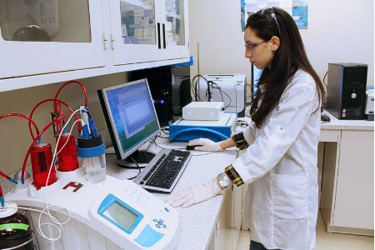Eliminate Microplastics In Wastewater Directly At Source

Professor Patrick Drogui’s research team has developed a process for the electrolytic treatment of wastewater that degrades microplastics at the source.The results of this research have been published in the Environmental Pollution journal
Wastewater can carry a significant concentration of microplastics into the environment. These small particles of less than 5 mm can come from our clothes, among other things, in the form of microfibers. Professor Patrick Drogui , who led the study, points out that currently, no degradation method is used to counter this contaminant during wastewater treatment. Existing techniques most often filter out pollutants, which requires additional efforts to manage the separated particles.
This is why the research team chose to study the degradation of particles by electrolytic oxidation, a process that does not require the addition of chemicals. “Thanks to electrodes, we generate hydroxyl radicals ( · OH) which attack microplastics. This process is respectful of the environment, because it degrades them in the form of CO 2 molecules and water, non-toxic for the ecosystem ”, explains the researcher. The electrodes used in this process are more expensive than iron or steel electrodes, which degrade, but they are reusable for several years.
Effective treatment
Professor Drogui is considering the use of this technology at the outlet of wastewater from commercial laundry plants, a potential source of microplastic releases to the environment. “When water from commercial laundries arrives at the wastewater treatment plant, it is mixed with large amounts of water, which dilutes the pollutants and makes them more difficult to break down. Conversely, by acting at the source, ie in the laundry room, the concentration of microplastics is higher per liter of water, and therefore more accessible for degradation by electrolytic means ”, reports the specialist in electrotechnologies and water treatment. .
In the laboratory, during tests carried out on water artificially contaminated with polystyrene, the degradation efficiency was 89%. The team plans to move on to real-water experiments shortly. "Real water contains other materials that can interfere with the degradation process, such as carbonates and phosphates which can trap radicals and reduce the performance of the oxidation process," says Professor Drogui, scientific manager of the Laboratory of environmental electrotechnologies and oxidative processes (LEEPO) .
If the technology demonstrates its effectiveness on real water from commercial laundries, the research group is planning a study to verify the cost of treatment and the adaptation of the technology to treat larger amounts of wastewater. In a few years, the technology could be implemented in a laundry room.
About the study
The article " Treatment of microplastics in water by anodic oxidation: A case study for polystyrene ", by Marthe Kiendrebeogo, Mahmood Reza Karimi Estahbanati, Ali Khosravanipour Mostafazadeh, Patrick Drogui and Rajeshwar Dayal Tyagi, appeared in the journal Environmental Pollution. The team received financial support from the Fonds de recherche du Québec - Nature et technologies (FRQNT), the CREATE-TEDGIEER program, the Natural Sciences and Engineering Research Council of Canada (NSERC) and the Canadian scholarship program. la Francophonie (PCBF).
Source: National Institute for Scientific Research (INRS)
